Biscoff Mysore Pak (Mysore Pakku) is a modern fusion twist on the classic South Indian sweet. Made with besan, ghee, oil, sugar, and optionally Biscoff butter for a caramel-spiced kick, this rich, aromatic dessert comes together in just 45 minutes - perfect for festive gifting, weekend indulgence, or special celebrations!
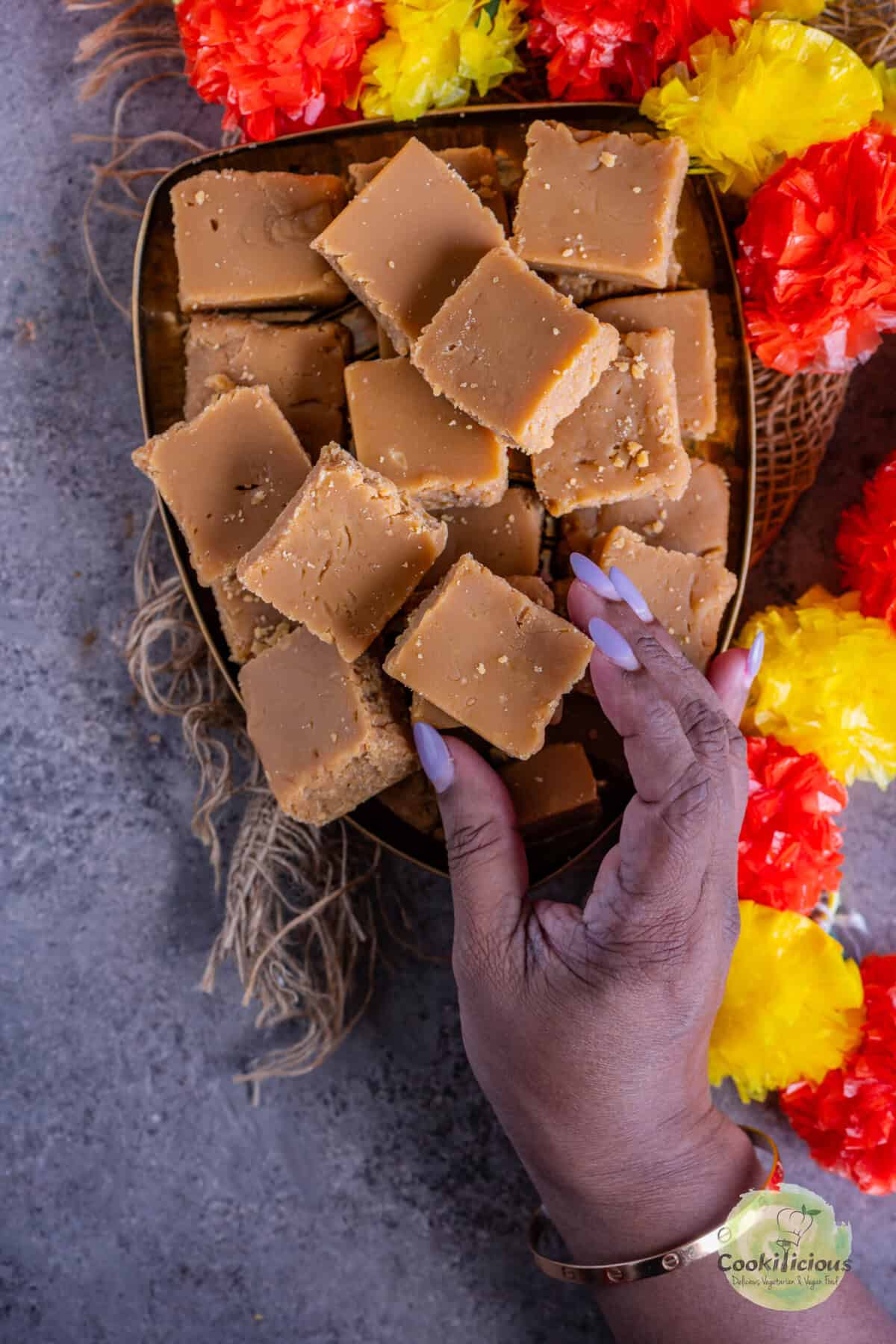
Jump to:
What Is Mysore Pak
Mysore Pak, also known as Mysore Pakku, is a beloved South Indian sweet made with just four humble ingredients - besan (gram flour), ghee, oil, and sugar. This iconic Indian dessert is known for its velvety, melt-in-the-mouth texture and rich, buttery aroma that fills the entire kitchen.
Legend has it that Mysore Pak was first created in the royal kitchens of the Mysore Palace by a cook named Kakasura Madappa, who crafted this ghee-laden sweet to impress the king. The word "Pak" refers to sugar syrup, which forms the base of this traditional treat.
Fun fact - Taste Atlas ranked Mysore Pak among top street-food sweets globally.
Soft vs Crumbly Mysore Pak: Which texture do you prefer
The beauty of Mysore Pak (Mysore Pakku) lies in its texture - some like it soft, smooth, and melt-in-the-mouth, while others prefer it crumbly, slightly firm, and porous.
The soft version of Ghee Mysore Pak, like the one made famous by Shree Krishna Sweets in India, has that luxurious, buttery feel that literally dissolves on your tongue. This texture comes from using more ghee and cooking the sugar syrup just until one-string consistency. It's indulgent, rich, and my personal favorite - that's the version I've recreated here.
The crumbly or hard version of Mysore Pak is equally beloved across South India, especially in old-school sweet shops and temple prasadam. It's made by cooking the syrup a little longer and using slightly less ghee, giving it that grainy, porous texture with a delightful bite.
Whichever you prefer, both styles celebrate the same timeless flavors of ghee, sugar, and besan - the difference lies in the balance of ingredients and your personal taste!
In our South Indian household, Mysore Pak has always been a symbol of celebration. It's one of those bakshanam or sweets that make every special occasion like weddings, and festival feel complete - often served alongside Paal Payasam, Semiyan Payasam, Rava Laddu, Coconut Ladoo, Pongal, and Carrot Halwa. Every bite brings back childhood memories of festive feasts and the comforting aroma of ghee wafting through the kitchen.
My Fondest Memory of Ghee Mysore Pak
Some of my sweetest childhood memories revolve around soft Mysore Pak. Every summer, we would visit my pati (grandma) in Trichy, where a month-long stay meant endless pampering, love, and home-cooked treats that only grandparents can create.
Our days were filled with culinary delights like Ammini Kozhukattai, Sambar, Rasam, Paruppu Usili, Avial, Paruppu Sevai, Thattai, Omapodi, Ellu Podi Sadam, Mor Kuzhambu, Paruppu Vada, Tomato Rice, and Rava Dosa-each dish a story, each bite a memory.
On the day of our departure, she would make a generous batch of Ghee Mysore Pak and Manga Urugai (mango pickle), packed carefully in repurposed containers for us to carry home. I remember standing in the kitchen, watching her make it, completely mesmerized. How I wish I had saved that recipe! Back then, I was too young to notice the technique-my only concern was when would I get to eat it! We treasured those treats like prized possessions, each bite a little piece of her love traveling home with us.
Those moments ingrained in me not just a love for the taste, but for the comfort, nostalgia, and the sheer joy that melt-in-your-mouth Mysore Pakku brings during festive or special moments.
Why Add Biscoff to Mysore Pak
This is my fusion twist to this south Indian classic dessert. I like to add some Biscoff butter to Mysore Pakku. It's totally optional but incorporating Biscoff into Mysore Pak introduces a rich, caramelized depth that enhances the traditional sweet's flavor profile. This Biscoff Mysore Pak fusion dessert creates a harmonious balance, adding a modern twist to a classic favorite.
- Color and Depth: Biscoff's caramelized sugar content contributes to a deeper hue and a more complex flavor, enriching the besan mixture with a warm, toasty undertone.
- Flavor Profile: The speculoos spices in Biscoff-cinnamon, nutmeg, and clove-add an aromatic lift that pairs beautifully with the traditional cardamom often used in Mysore Pak.
- Texture Variations: Incorporating Biscoff can be done in two ways: mixing it directly into the batter for a uniform flavor or sprinkling crushed Biscoff biscuits on top for added texture and crunch.
If you love giving traditional Indian desserts a creative fusion twist, don't miss these unique sweet treats - Caramel Kalakand, Caramelized Sabudana Kheer, Chai Cheesecake, Rabdi Cheesecake, Rasmalai Cheesecake, Carrot Halwa Ice Cream, Gulkand Ice Cream, Karanji Baklava, Gulkand Shrikhand Tarts, Carrot halwa Baklava, Gulab Jamun Kulfi, and Paneer Gujiya Shells.
Each one blends classic Indian flavors with modern flair - perfect for festive celebrations or indulgent weekend desserts.
Why Make It
- A Classic South Indian Festive nut-free Sweet 🪔 - Celebrate festivals or special occasions with this iconic Mysore Pak, cherished for its melt-in-the-mouth, ghee-rich texture.
- A Fun Fusion Dessert 🍪 - Add a twist with Biscoff for a subtle caramel-spiced flavor that elevates the traditional recipe.
- Simple Ingredients, Big Flavor 🥄 - Made with just 5 basic pantry staples: besan, ghee, sugar, oil, and optional Biscoff butter, this sweet is both accessible and indulgent.
- Ready in 30 Minutes ⏱ - Perfect for weeknight cravings, last-minute Diwali treats, or festive prep without long hours in the kitchen.
- Make Ahead and Gift-Worthy 🎁 - Prepare in advance and store in an airtight container. These buttery, fragrant squares make for a thoughtful homemade gift.
🧾 Ingredients Needed
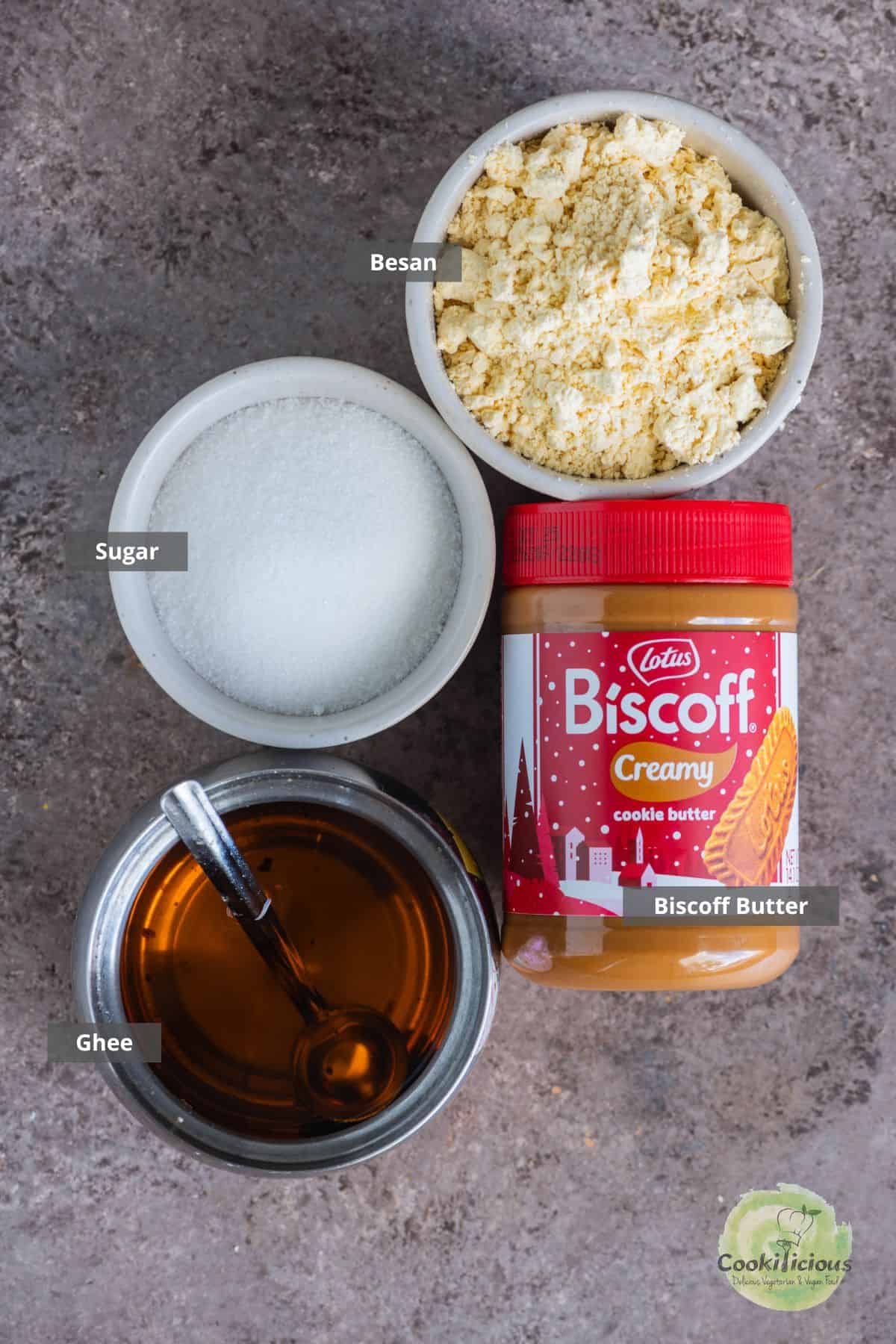
Besan / Gram Flour - This is the heart of Mysore Pak. You can find besan in Indian grocery stores or online (Amazon). Always choose good-quality, fresh, fine-textured besan to ensure soft, melt-in-the-mouth squares.
Fun fact: besan is incredibly versatile - you can also use it to make Kurkuri Bhindi, Fajeto, Mor Kuzhambu, Potato Squares, Onion Pakora, Tomato Omelet, Bombay Chutney, Kara Boondi, and Omapodi.
Sweetener - Traditional white sugar is essential in this South Indian dessert because we need to make a proper sugar syrup for the classic texture of Mysore Pakku. I haven't experimented with alternatives, as sugar gives the perfect balance of sweetness and structure.
Oil and Ghee - Both are crucial for the signature aroma, richness, and consistency of melt-in-your-mouth Mysore Pak. Use any neutral vegetable oil; I've personally used Saffola cooking oil with great results. And please, invest in good-quality ghee-it truly makes a difference in flavor and melt-in-your-mouth texture.
Biscoff Butter (Optional) - Adding Biscoff is a fun twist that brings caramelized, spiced cookie notes to your homemade Mysore Pak, without changing the classic base. It's perfect if you want to try a fusion Mysore Pak or make it a bit more modern for gifting or parties. To take it up a notch, crumble Biscoff biscuits and sprinkle on top of the Mysore Pak.
Use a heavy-bottomed kadai or thick heavy pan rather than ultra non-stick when making this traditional South indian sweet, so the sugar syrup and besan heat evenly and don't scorch.
How To Make It 🔪
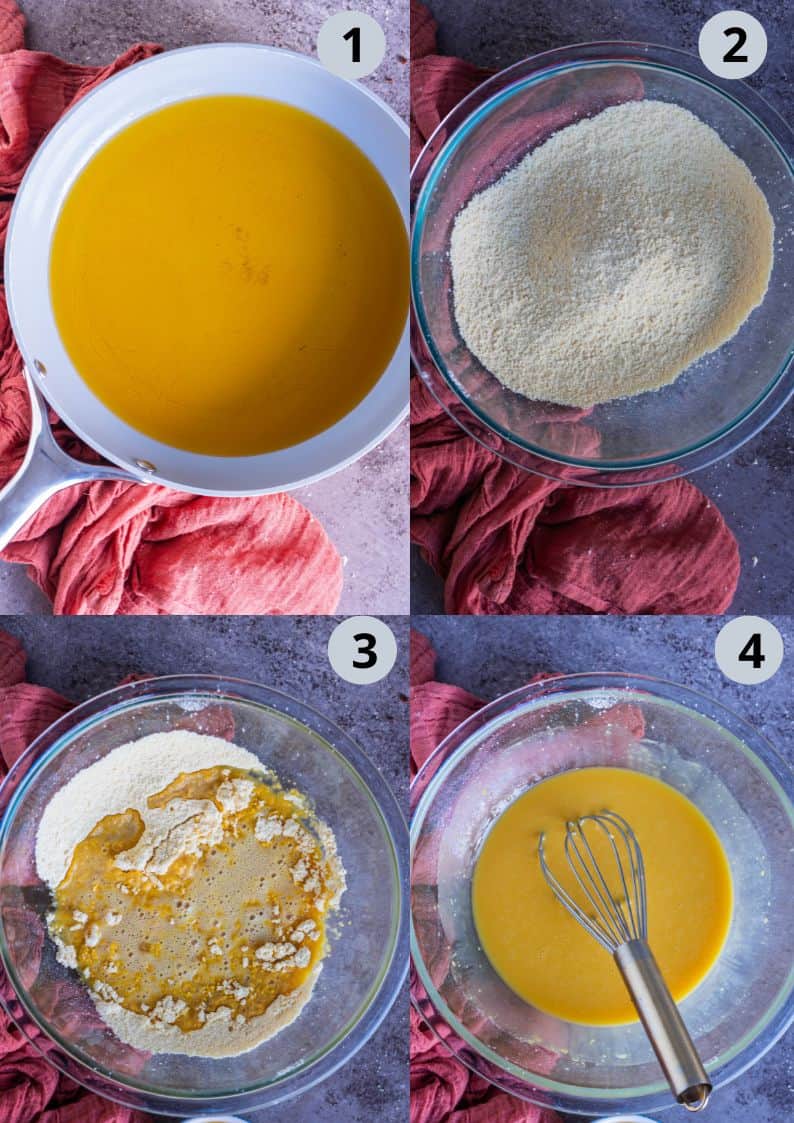
- Heat the ghee and oil lightly in a pan. It should just become warm-this usually takes 6-7 minutes on medium flame.
- Sieve the gram flour (besan) into a mixing bowl to remove lumps and ensure a smooth batter.
- Carefully remove ½ cup of the warm ghee-oil mixture into a small bowl for later. Pour the remaining ghee-oil into the besan.
- Whisk the mixture until smooth and lump-free.
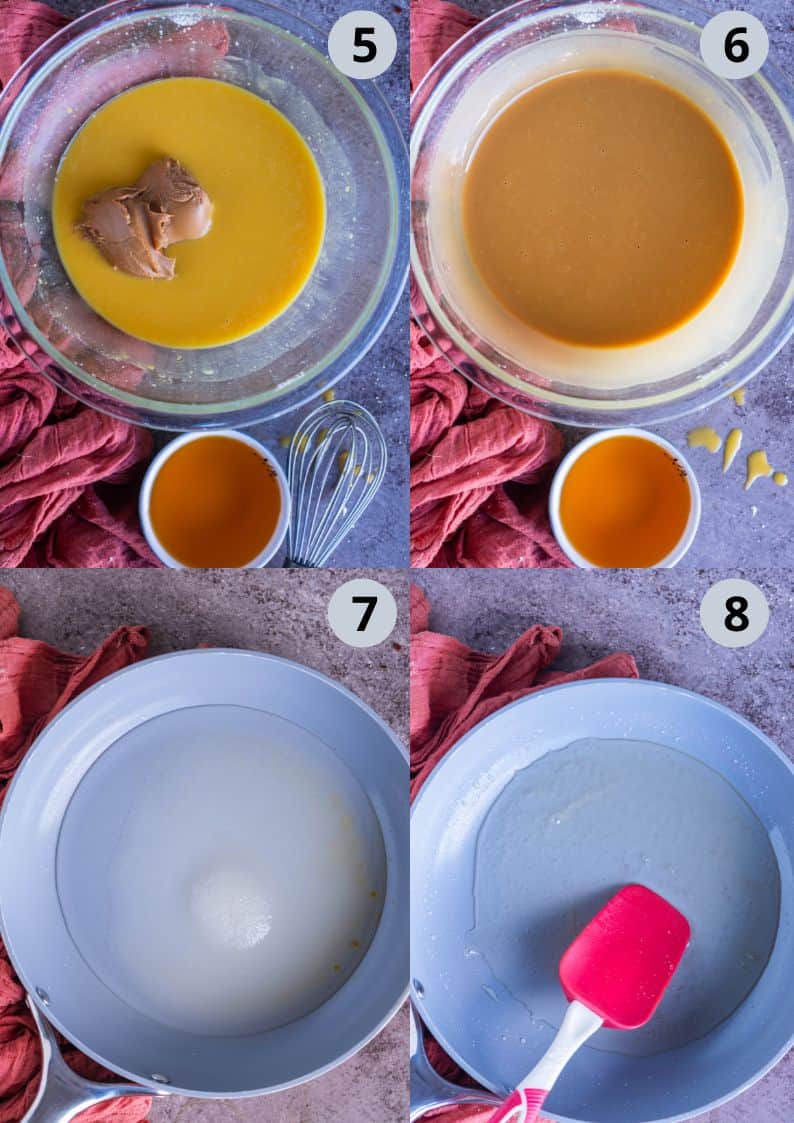
- Add Biscoff butter (optional) for a subtle caramel-spiced flavor.
- Whisk again until fully incorporated.
- In a nonstick pan, combine sugar and water and heat over medium flame. Stir until the sugar dissolves completely.
- Bring the syrup to a gentle boil and cook until it reaches one-string consistency (about 10-12 minutes on medium flame).💡 Tip: Touch a drop between your thumb and forefinger-if a single thread forms, it's ready. This stage is key for getting that perfect soft, melt-in-the-mouth Mysore Pak texture.
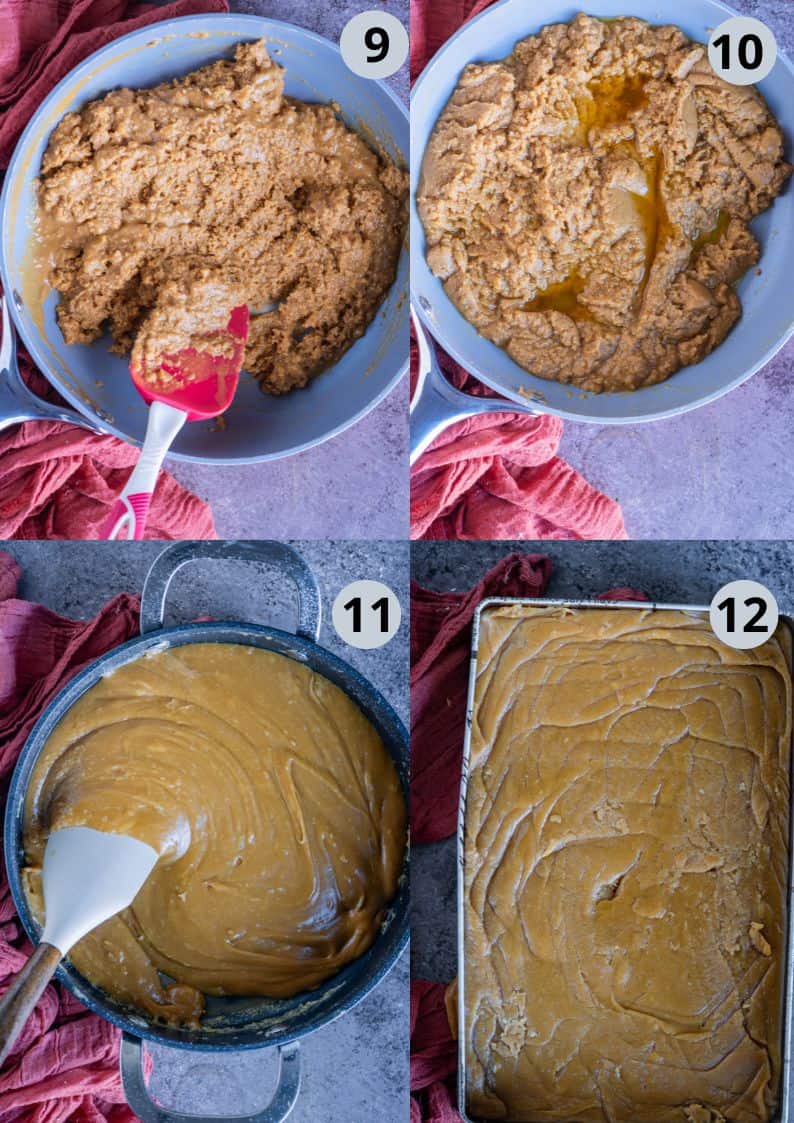
- Pour the besan mixture into the sugar syrup and stir continuously to avoid lumps.
- Gradually add the reserved ghee-oil mixture in intervals, stirring constantly. Cook on medium-low heat for about 5 minutes, until the mixture turns glossy, bubbly, and begins to leave the sides of the pan. You'll notice tiny air bubbles or froth forming-this is your cue to turn off the heat. Cooking it longer will yield a crumbly, porous Mysore Pak instead of a soft, melt-in-the-mouth one.
- Turn off the heat and stir for an additional minute; the mixture should be thick, smooth, and spreadable. It should also not stick to the pan anymore.
- Pour the mixture into a greased mould and spread it evenly with a spatula.
Chef's tip: For an extra Biscoff boost, crumble a few Biscoff biscuits on top before it sets-this adds texture and deepens the caramel-spiced flavor of your Biscoff Mysore Pak.
Let it cool at room temperature for about 30 minutes. In hot or humid climates, allow more cooling time or refrigerate briefly to help it set. Then slice into neat squares. When cut, the pieces should have a uniform golden color, a few fine air pockets, and should neither ooze ghee nor stick to your fingers.
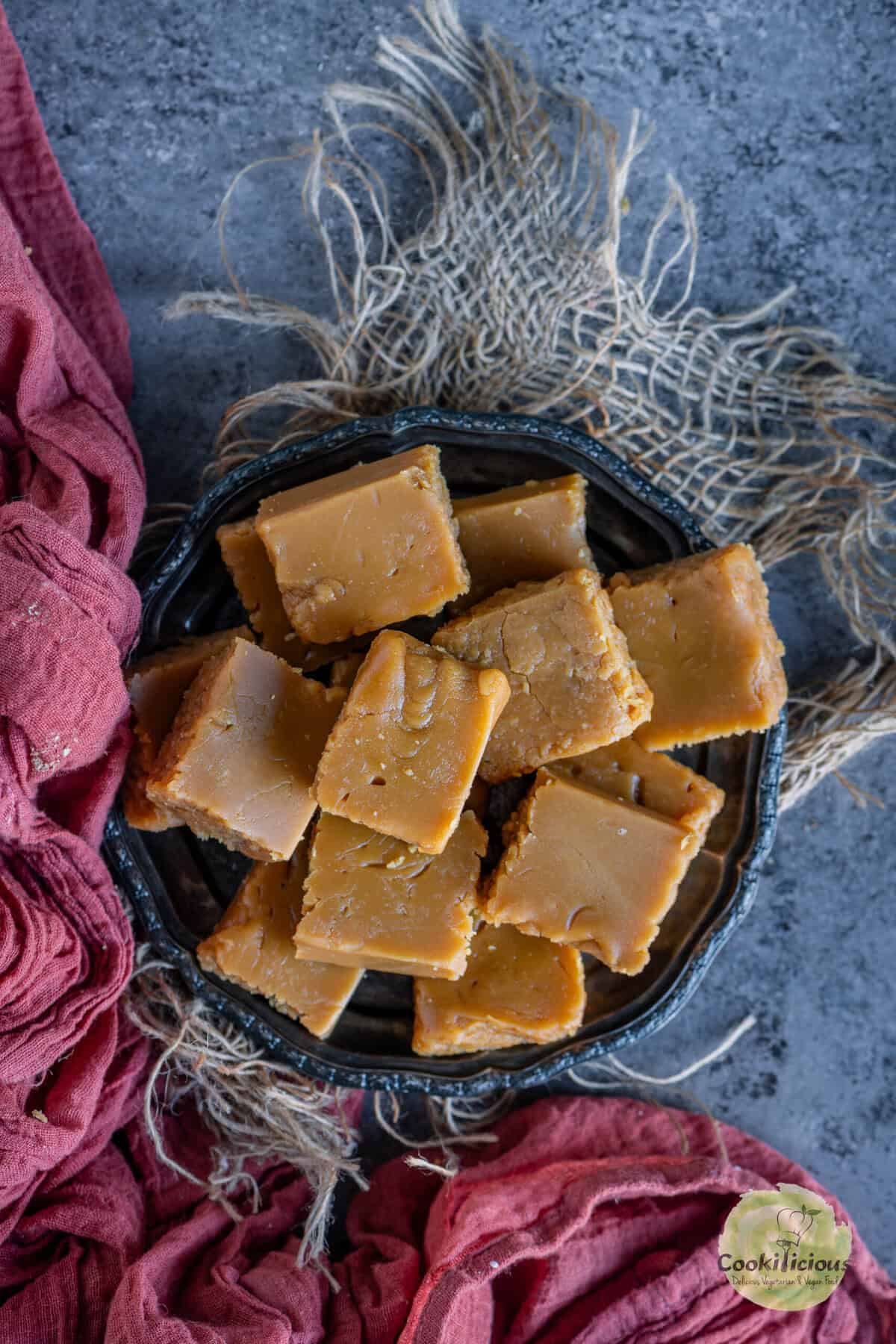
🍽 Serving Suggestions
Once set, slice your soft Biscoff Mysore Pak into neat squares or diamonds and serve them fresh - they taste best when slightly warm and aromatic from the ghee. You can also store them in an airtight container and enjoy them later with a cup of chai or filter coffee.
These golden, ghee-rich sweets are perfect for any Indian festival or celebration. Serve them on a festive platter during Diwali, Ganesh Chaturthi, Navratri, Pongal, or Nombu - they fit beautifully into any traditional sweet thali.
Soft Mysore Pak also makes a thoughtful homemade gift during holidays and celebrations. Wrap a few pieces in decorative boxes and share them with family and friends for birthdays, weddings, anniversaries, housewarmings, or even Thanksgiving and Christmas - the caramel-rich, buttery flavor always wins hearts across cultures.
If you're hosting a brunch, potluck, or weekend get-together, include homemade Mysore Pakku on your dessert table or your mithai charcuterie board. It's a timeless treat that adds instant festive charm to any occasion!
💭 Priya's Recipe Tips
Once you add the besan-ghee mixture to the sugar syrup, avoid overcooking - this step is key to achieving that soft, melt-in-the-mouth Mysore Pak texture. The mixture will thicken quickly and start to leave the sides of the pan as you gradually pour in the remaining ghee. Keep stirring continuously on medium-low heat until it turns smooth, glossy, and slightly frothy - that's your cue to transfer it immediately to the greased tray. Overcooking at this stage can make your Mysore Pakku dense or hard, so timing is everything!
FAQs 📖
Absolutely! You can make classic Mysore Pak without adding Biscoff butter. The recipe stays exactly the same-Biscoff is purely an optional twist to introduce a caramel-spiced flavor. If you skip it, simply follow the usual proportions of besan, ghee, and sugar, and you'll still get the same soft, melt-in-the-mouth, ghee-rich squares that make Mysore Pak so irresistible. This way, you can enjoy the authentic taste and texture of this iconic South Indian sweet, perfect for festivals, special occasions, or gifting, without any modifications.
If your Mysore Pak didn't turn out as soft and melt-in-the-mouth as you hoped, the most common culprit is the sugar syrup consistency. Getting the one-string consistency just right is the heart of a perfect Mysore Pak. It comes with little practice. Overcooking the syrup can make the sweet hard, while undercooking it leaves it greasy or crumbly.
Other factors that affect the texture include:
Not stirring continuously: Once you add the besan mixture to the syrup, you must keep quick in stirring to avoid lumps and uneven cooking.
Using old or coarse besan: Always use fresh, fine-textured gram flour for the best results. Stale besan can make your Mysore Pakku grainy and uneven.
Cooking on high heat: The mixture can seize or burn quickly. Maintain a medium to low flame throughout to let the sugar and ghee emulsify properly.
Adding ghee too quickly: Incorporate the ghee-oil mixture gradually so it absorbs evenly, resulting in that signature porous yet smooth Mysore Pak texture.
Follow my recipe step-by-step, and you'll get soft, ghee-rich, and perfectly balanced Mysore Pakku every single time!
One of the best things about Mysore Pak is that it stays fresh for quite a while thanks to the generous amount of ghee used in it. Store it in an airtight container at room temperature for up to a week-no need to refrigerate.
If you love soft, melt-in-the-mouth Mysore Pak, avoid refrigerating it as it tends to firm up when chilled. However, if you prefer a slightly firmer, crumbly texture, you can refrigerate it-it will last up to 2-3 weeks.
For longer storage, freeze the Mysore Pak in freezer-safe containers or ziplock bags for up to 2 months. When you're ready to enjoy it, thaw it overnight in the fridge and warm it for a few seconds in the microwave to bring back its signature softness and rich aroma.
Traditional Mysore Pak relies on ghee for that rich, melt-in-the-mouth texture, but you can absolutely make a vegan version at home. Simply substitute vegan ghee or plant-based ghee for the regular ghee - the texture will remain buttery and smooth, though the flavor will be slightly different.
The rest of the ingredients - besan (gram flour) and sugar - are naturally vegan, so you can enjoy a plant-based Mysore Pakku that's perfect for festivals, gifting, or indulgent treats without compromising your dietary choices.
Need to Substitute An Ingredient Or Didn't Find The Answers You Were Looking For?
Ask AI To Answer Based On This Specific recipe:
* Disclaimer - I am not responsible for the quality of suggestions AI makes.
More Dessert Recipes
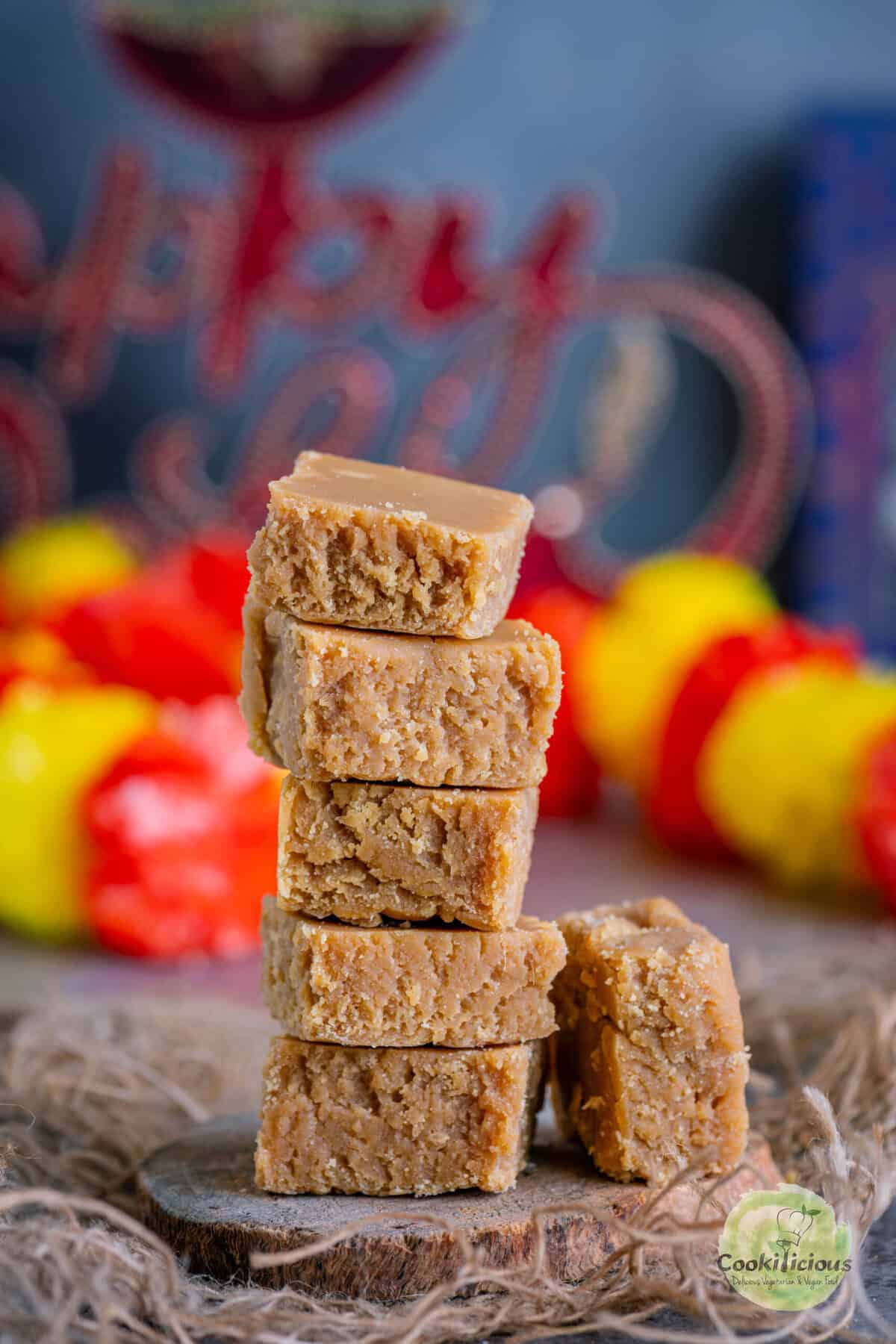
⭐️ Subscribe to the Cookilicious Newsletter and receive new recipes straight to your inbox! You'll receive my FREE Vegan Beginner's guide as a gift. Ready to elevate your cooking game? Purchase my Cookbook - The Essential Vegan Indian Cookbook today!
Recipe 📖

Biscoff-Infused Mysore Pak
Equipment
Ingredients
- 1 cup Besan or gram flour
- ¾ cup Oil
- ¾ cup Ghee
- ½ cup Biscoff butter optional
- ¾ cup Sugar
- ½ cup Water
Instructions
- Heat the ghee and oil lightly in a pan. It should just become warm-this usually takes 6-7 minutes on medium flame.
- Sieve the gram flour (besan) into a mixing bowl to remove lumps and ensure a smooth batter.
- Carefully remove ½ cup of the warm ghee-oil mixture into a small bowl for later. Pour the remaining ghee-oil into the besan.
- Whisk the mixture until smooth and lump-free.
- Add Biscoff butter (optional) for a subtle caramel-spiced flavor.
- Whisk again until fully incorporated.
- In a nonstick pan, combine sugar and water and heat over medium flame. Stir until the sugar dissolves completely.
- Bring the syrup to a gentle boil and cook until it reaches one-string consistency (about 10-12 minutes on medium flame).💡 Tip: Touch a drop between your thumb and forefinger-if a single thread forms, it's ready. This stage is key for getting that perfect soft, melt-in-the-mouth Mysore Pak texture.
- Pour the besan mixture into the sugar syrup and stir continuously to avoid lumps.
- Gradually add the reserved ghee-oil mixture in intervals, stirring constantly. Cook on medium-low heat for about 5 minutes, until the mixture turns glossy, bubbly, and begins to leave the sides of the pan. You'll notice tiny air bubbles or froth forming-this is your cue to turn off the heat. Cooking it longer will yield a crumbly, porous Mysore Pak instead of a soft, melt-in-the-mouth one.
- Turn off the heat and stir for an additional minute; the mixture should be thick, smooth, and spreadable. It should also not stick to the pan anymore.
- Pour the mixture into a greased mould and spread it evenly with a spatula.Chef's tip: For an extra Biscoff boost, crumble a few Biscoff biscuits on top before it sets-this adds texture and deepens the caramel-spiced flavor of your Biscoff Mysore Pak.Let it cool at room temperature for about 30 minutes, then slice into neat squares. In hot or humid climates, allow more cooling time or refrigerate briefly to help it set. When cut, the pieces should have a uniform golden color, a few fine air pockets, and should neither ooze ghee nor stick to your fingers.

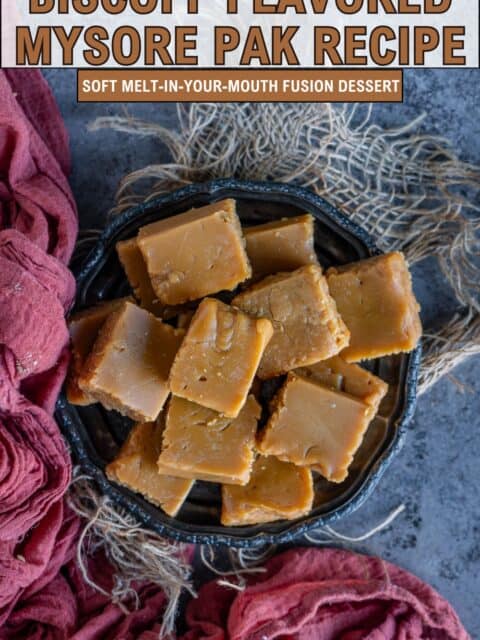

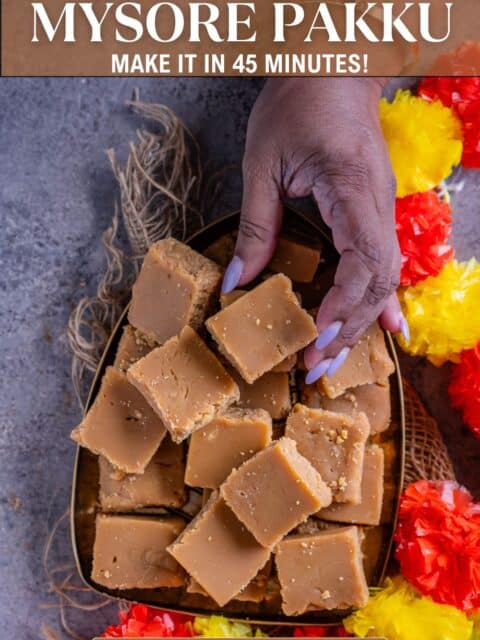
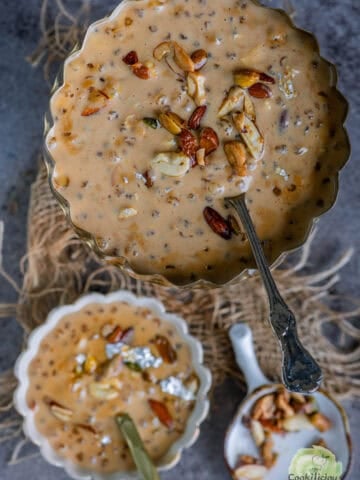
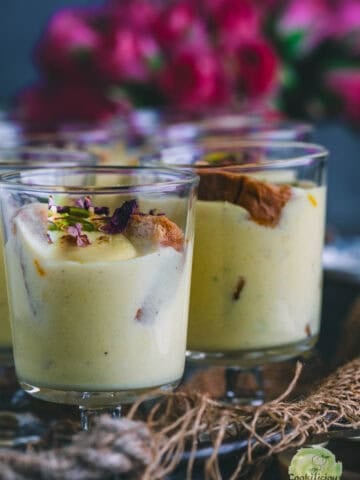
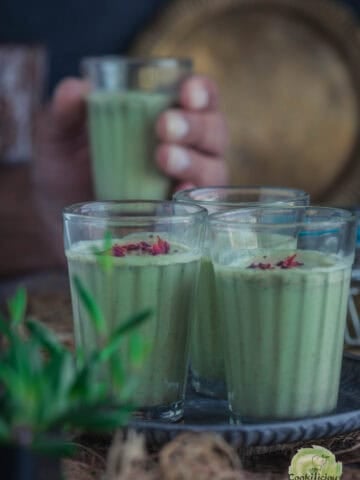

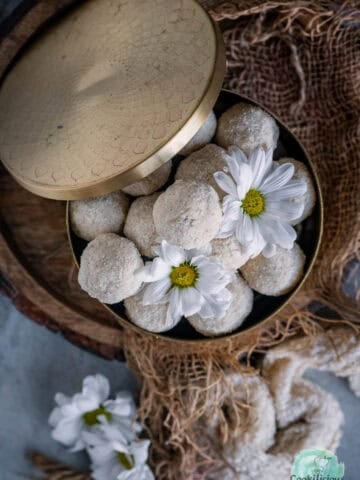
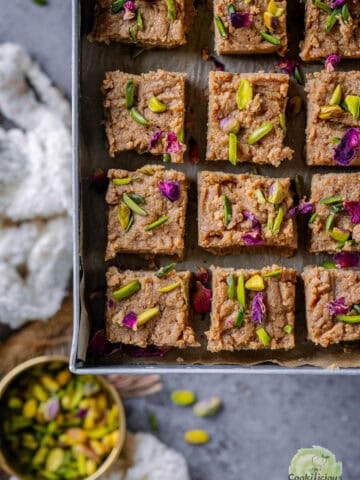
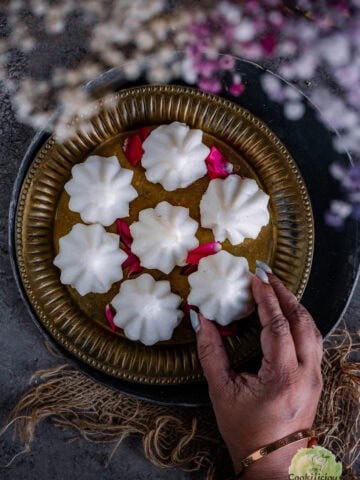

Anonymous says
Supremely delicious!!!